new posts in all blogs
Viewing: Blog Posts Tagged with: Tips for Teachers &, Most Recent at Top [Help]
Results 1 - 21 of 21
How to use this Page
You are viewing the most recent posts tagged with the words: Tips for Teachers & in the JacketFlap blog reader. What is a tag? Think of a tag as a keyword or category label. Tags can both help you find posts on JacketFlap.com as well as provide an easy way for you to "remember" and classify posts for later recall. Try adding a tag yourself by clicking "Add a tag" below a post's header. Scroll down through the list of Recent Posts in the left column and click on a post title that sounds interesting. You can view all posts from a specific blog by clicking the Blog name in the right column, or you can click a 'More Posts from this Blog' link in any individual post.
by Carol Fraser Boles, Literacy Specialist for the National Writing for Children Center
Every year student assessments show that when kids take a break from school over the summer and they don’t read or have any reading instruction during that time, their reading skills are adversely affected. But this doesn’t HAVE to happen. Encouraging children to read during the summer will not only sustain their current reading achievement, it will also contribute to their success in reading proficiency.
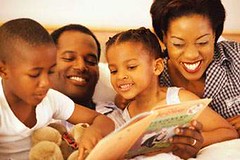
Here are a dozen ways parents can get their children to read over the summer and have fun doing it. These activities will support and extend reading achievement during the summer months.
For Early Primary Grade Children
Start a Car Library - Buy books then leave them in the car. When running daily or weekly errands together, your children will have books available to read and explore while accompanying you on these trips.
Create a Reading Schedule – Designate a “reading time” each day. At this time read aloud or listen to your children read.
Make Regular Library Visits -Take out the calendar and mark down each day during the summer when visits to the library will take place. Make an effort to visit the library at least once a week. When you’re there, let your children explore the picture book area of the library. Allow your children to check out books that appeal to them. Read these books aloud over and over to your children, or listen to them read the books to you (if they can) over and over again.
Visit the BookStore – Again, take out the calendar and mark down days that visits to bookstores will happen. Bookstores today have delightful children’s books sections, where you children can explore vividly illustrated picture books. Allow your children to select one or two books, depending on your budget, to start or expand their own home libraries.
For Intermediate Grade Children
Create a Neighborhood Book Club – Children this age are very social. Initiate the book club by designing a flyer that describes what the book club is going to be about. Have your children pass it along to their friends and other children in the neighborhood. Schedule a specific time each week when book club members will meet to talk about the books they’re reading. Provide inexpensive treats for the kids, and ask other parents to sign up to provide snacks as well.
Have a Book Swap – During book club meetings suggest students swap books they might have at home and no longer want or need.
Make Reading Fun – Students not only need to learn how to read stories, they need to learn how to read directions. Find simple recipes and have book club members make treats for their meetings once in a while.
Integrate Art with Reading – Provide construction paper and a variety art media such as: colored pencils, markers, water colors. Encourage book club members to design a new book cover for the book they are currently reading.
For Secondary Grade Children
Most teenagers have summer jobs, so pulling off some of these activities might be tricky.
Have Your Teen Tutor a Younger Child: Make arrangements for your teenager to read aloud to and tutor a younger student. Tutoring others teaches teenagers their civic responsibility, boosts their self-esteem (as well as the self-esteem of the student being tutored). It also sends the message that reading is an important skill to have.
Read One of the Classics Together – Get two copies of: To Kill
by Carol Fraser Boles, Literacy Specialist for the National Writing for Children Center
Students who are accomplished, voracious readers possess an awareness of the genre they like to read, and they become lifelong readers. In contrast, many students struggle to find the “right” books to read, and they never develop a love or appreciation for reading.
Research consistently reveals that children who spend time reading silently, within their classrooms, make annual gains in reading achievement. With this revelation in mind, teachers need to recognize the importance of independent reading time—during the school day— while also recognizing that students must be allowed to choose books that appeal to them, and those that reflect their interests and reading abilities. Teachers can teach their students how to find the “right” books by conducting teacher-student interviews.
Note: The sequences involved in guiding children toward learning how to choose books, which are appealing and appropriate for them, varies depending upon the students’ grade level, i.e. primary, intermediate, secondary.
The teacher can choose a few books that he/she thinks the student interviewed might enjoy. Here are some typical questions the teacher might ask a student about each of the books presented to the student during a teacher-student interview:
After looking at the cover, other illustrations and pictures, do you think you will find this book entertaining? Why?
Is this book about something that interests you?
What do you already know about the topic, author, time in history?
Look through the book. Does this story use words you hear in everyday life, and understand? Give some examples.
Is the length of this book too long or too short for you? Explain.
As we read the first few pages together, do you understand the story/ does it make sense so far?
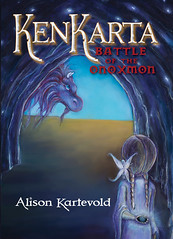 Introduce Young Girls to the Adventure/Fantasy Genre with KenKarta
Introduce Young Girls to the Adventure/Fantasy Genre with KenKarta
Most adults have developed criteria for selecting books, but most students have not acquired this skill. In order for students to develop a preference for certain genres, teachers need to teach them how to select books thoughtfully. Teacher-student interviews about choosing books will not only increase students’ reading achievements, but simultaneously develop their appreciation for books.
For more and articles and information on teaching children how to choose books to read, visit www.carolfraserboles.com.
by Amy M. O’Quinn, Home School Specialist for the National Writing for Children Center

Teaching a child to read may seem like a mysterious process—whether the parent is the ‘main’ instructor or simply the home facilitator helping out during after-school hours. We all want our children to learn to read well, because we know that good literacy skills are critical for an excellent education and can open many windows of opportunity in life.
However, we should also realize that children learn to read in different ways and according to various time spans. I know from my own experience in teaching my six children to read that they have each mastered reading anywhere from the age of four to the age of seven—and that is okay. No two children are ever the same and their learning processes will vary. I have simply discovered that consistency is imperative when it comes to teaching a child to read. Patience and encouragement are also key elements in the process—for both the teacher and student!
The most important role we can play in our child’s reading journey is to make them feel successful. When tension mounts and frustration levels rise, perhaps it is time to back off just a bit, take a deep breath, regroup, and remember that this IS a process. Moreover, readiness is also a factor, so don’t worry—just keep moving forward. There is a balance between pushing too hard and challenging our children to take their skills up to the next level. However, as parents, we can normally discern between the two, and that’s why ‘reading’ our children is so important. We want the process to be enjoyable—yet we want them to use their abilities to the fullest! Concentrate on strengths, but consistently (and gently) guide them through their weaknesses as time and readiness permit.
Several factors contribute to successfully teaching children to read:
1. Read to them early and often. Talk with them about what you are reading. Research confirms that hearing language is an important part of learning to read.
2. Stock your shelves with ‘living’ books for all ages. Availability and immersion are important.
3. Repetition and consistency are vital for fluency. Confidence grows with mastery.
4. Model reading. When children see their parents reading, they get the message that books and reading are enjoyable. They will want to do the same. According to Jim Trelease in The Read-Aloud Handbook:
“In concentrating exclusively on teaching the child how to read, we have forgotten to teach him to want to read…Somehow we lost sight of the teaching precept: What you make a child love and desire is more important than what you make him learn.”
5. Remember that reading is a process, and children will learn and develop their skills at different rates. Try not to compare. Start where they are and build a foundation.
6. Find good resources and curriculum materials that work FOR YOU AND YOUR CHILD. Just because your friend’s child learned to read with ‘Product X’ doesn’t mean it is the right choice for you.
7. Fill your home with language, creativity, inspiration, and enthusiasm for learning.

by Carol Fraser Boles, Literacy Specialist for the National Writing for Children Center
The thought process children (or anyone) goes through to understand what they are reading involves a specific sequence of steps. These steps are: predicting, reading, verifying and clarifying, reading.
Predicting* – Requires the student to scan a book or text, then make viable predictions about what he thinks he is going to read.
Reading – Student reads a short portion of the story/text.
Verifying –After reading several passages, or a chapter the student then verifies whether his predictions were correct. At this point, the student also summarizes what he has just learned.
Reading – Student continues reading the story/text.
Clarifying- Student stops reading, thinks about what he has read, retrieves previous knowledge, attaches new knowledge (the information he has just read) to this previous knowledge, then assimilates this new knowledge into his mind. Again, the student is also summarizing what he has just learned from what he read.
Basically, while reading a book or a story or other text, readers keep repeating all the steps in this thought process.
Making students aware of this thought process allows them to learn to monitor their own thinking. Accomplished readers instantly know whether they understand (comprehend) what they are reading, and conversely when they are not. When the latter is the case, good readers automatically re-read for clarification and understanding.
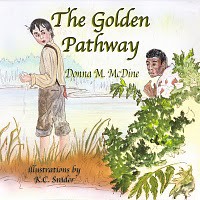
Elementary school teachers looking for a book to help their students learn to monitor their thinking as they read might begin with Donna McDine’s book, The Golden Pathway, about the underground railway. Here is a list of steps to follow while reading The Golden Pathway:
1. Flip through the pages, look at the pictures, illustrations, chapter.
2. Ask students to generate predictions based on the illustrations and the title of the book.
3. Read the first two to three pages of the book. Verify predictions and clarify students’ understanding so far. Let them summarize what they’ve learned about the story up to this point.
4. Repeat this process throughout the The Golden Pathway.
5. After reading this story, engage your class in a discussion about this story, and summarize its message.
6. Extend today’s lesson. Generalize the topic of this story—slavery. Apply the reading/thought process your students learned today to chapters or passages within your social studies textbook.
7. Follow the same procedure—preview the chapters, ask students to make predictions based on chapter titles, bold faced print, sub titles, pictures and illustrations.
*Predicting is not about making wild guesses. Predictions are based on existing knowledge about particular topics, and visual and textual clues provided before reading.
For more articles and information on reading and the importance of prediction, verifying and clarifying, visit www.carolfraserboles.com.
by Amy M. O’Quinn, Home School Specialist for the National Writing for Children Center
Picture books come in all different, shapes, sizes and subject matter. Some are funny, and some are sad. Some of fictional, and some are non-fiction. Some tell a sweet story, but others can be used to introduce topics that are somewhat sensitive, yet important for children to know about. Even older children can benefit from the ‘picture book application’ as they learn about subject matter or social/emotional topics that sometimes require a gentler or simpler, more straightforward approach. In fact, picture books are often used as part of “bibliotherapy,” which helps students understand and solve problems through the use of appropriate books.
For example, picture books make an excellent resource to introduce and discuss such topics as the death of a family member or pet, sickness, family problems, handicaps and disabilities, different kinds of abuse, peer pressure, self-esteem, etc. Children respond well to the picture book format because it is familiar to them, and parents and teachers might find it easier to share a topic in story form before attempting a discussion or explanation, as it opens up the opportunity for questions or dialogue.
Picture books can also be used to introduce events throughout history that affected certain groups of people. For example, there are many books about the Underground Railroad, which address the topics of slavery and discrimination. The reality of slavery is harsh, and children need to understand the consequences and injustice of such an institution and how people in the past (and sometimes, even the present) suffered and often died because of the color of their skin. Yet, how can we introduce a topic in such a way that the young children of today can understand? Could a story act as a segue into the subject matter? In many instances, I believe the answer is—yes.

Donna McDine’s book, The Golden Pathway, is an excellent example of a picture book that can introduce children to the harsh realities of slavery and how individuals risked death to escape to freedom or help others who wished to escape their circumstances.
Donna doesn’t sugarcoat the topic of slavery in her book at all; in fact, one of the first scenes deals with the severe beating of a slave named Jenkins. However, she handles the subject matter in such a way children can understand. In addition, her main character David, the son of the slave owner, is a fine example of bravery and kindness, with the kind of qualities to be admired and hopefully emulated.
To give a better idea of the book’s contents, here is a description from the author:
Raised in a hostile environment where abuse occurs daily, David attempts to break the mold and befriends the slave, Jenkins, owned by his Pa. Fighting against extraordinary times and beliefs, David leads Jenkins to freedom with no regard for his own safety and possible consequences dealt out by his Pa. Suggested age for readers 8-12
The Golden Pathway is an excellent introduction to a sensitive topic, and one that can be used to open the door to discussion and evaluation of a harsh reality in our country’s history. Yet, the picture book format lends itself well to the audience. This approach benefits the student and the teacher, and it is something to consider!
***************
Visit Amy at
5 Comments on Using Picture Books to Introduce Sensitive Topics to Children, last added: 4/8/2011
by Dorit Sasson, ESL Specialist for the National Writing for Children Center
Before they even begin school, ESL children have already absorbed the grammatical structures, sounds, and vocabulary of a language. This assumption takes into account that parents speak with their children in their own mother tongue from a very young age. But what about building literacy skills for a second language? Research shows that ESL students are not reaching the same levels of reading proficiency as their native English speaking peers by the time they reach third grade.
Using children’s trade books (i.e. read-alouds) is a great way for parents and teachers to help build literacy skills for ESL students.
Bridging Oral Work with Vocabulary Development
Teachers and parents can make sure specific aspects of oral instruction correspond to vocabulary development and story comprehension of their respective curriculums. Young ESL students at the first stage of reading development (ages 6-7) are generally aware of sound-letter relationships, can map speech to print and sounds out words, attempts to break code of print and uses decoding to figure out words (Roskos, et.al). Less skilled readers however, do not have the automaticity in lower-level process (i.e., letter, word levels) to process information at the vocabulary level without expending a great deal of cognitive effort.
Use Language Scaffolds
In a read-aloud context, teachers and parents can provide a range of language scaffolds so that ESL students can map out the basic story components of plot and character and understand basic vocabulary integral to the read-aloud.
Such language scaffolds that naturally bridge the oral and written aspects of the curriculum include:
* Using simple and concrete language to introduce and discuss new vocabulary
* Using modeling strategies to help facilitate with comprehension
* Anticipating and predicting further content
* Encouraging ELLs to make connections with what they have heard
In order to ensure that ESL students understand 99% of a spoken text, teachers need to provide opportunities to discuss vocabulary in context, otherwise ESL students may spend an inordinate amount of their cognitive energies trying to guess at the word’s meaning thus losing the flow of the story. The read-aloud story gives teachers a framework with which to teach the letters, words or other stories.

Before teachers focus on new vocabulary words, they may need to check students’ familiarity with the context. In the story Bear Snores On by Karma Wilson, for example, the word gloves should be associated with cold and hands. Teachers will want to teach new vocabulary, such as the word gloves, in the context by providing contextual clues to help students recognize the meaning either independently or with the teacher’s help.
Other examples include:
* Teacher discusses the word ‘grouchy’ as the underlying theme for Eric Carle’s The Grouchy Ladybug using a picture of a grouchy face.
* Teacher explicates the word ‘snores’. What does the bear do when he is sleeping?
Non-verbal (i.e. gestures) and verbal clues (i.e. pictures) facilitate the process of scaffolding between hearing words and seeing them in their respective contexts befo
by Suzanne Lieurance
As a former classroom teacher, I love to see a wonderful middle grade novel that has a compelling story kids will love. But I’m particularly pleased when a novel can be used to transport young readers to another place and time so they learn a bit about another place and culture. A good example of a middle grade novel that manages to do all this and more is Taconi and Claude, Double Trouble by M.E. Finke.
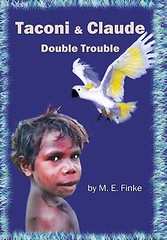
Set in the Australian outback of the 1950s, Taconi and Claude is a coming-of-age story told through the eyes of an aboriginal boy named Taconi whose “best mate” just happens to be a wise-cracking cockatoo named Claude. As the story opens, Taconi is apprehensive about his upcoming Manhood Ceremony.
From the first page of this lively story, it’s evident that Finke took great care in choosing every word for this amazing tale. Young readers will be introduced to all sorts of rich and colorful characters, places, and words they’ve never heard of before, which is one reason a reading/learning strategy known as K-W-L is a good choice to use to guide students through this story. It’s not that they won’t be able to follow the plot or storyline without guidance. They’ll be able to do that just fine. But there are so many rich details along the way, a teacher or parent will want to be sure young readers don’t miss any of them. A K-W-L chart will help them stay focused.
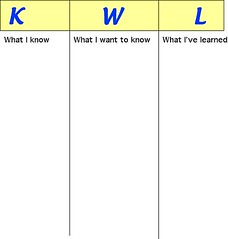
Here’s how K-W-L works. The letters stand for:
K – Know (As in “What do you already know about this subject?”)
W – Want to Know (As in “What do you want to know about this subject?” – or – “What do you THINK you will probably learn about this subject from reading this book?”)
L – Learn (As in, “What did you just learn from reading a chapter or chapters of this book?”)
The teacher or parent asks the reader to fold a piece of notebook paper in thirds, lengthwise, producing three columns.
The first column is the K column. This column is completed BEFORE the reader starts to read the book. The parent or teacher asks an open ended question like, “What do you already know about Australia?” or “What do you already know about manhood ceremonies?”
The reader jots down everything he knows (or THINKS he knows) in answer to these questions.
The second column is the W column. This column is also completed BEFORE the reader starts to read the book. The parent or teacher might ask these questions, “What do you want to find out about Australia?” or “What would you like to learn about manhood ceremonies?”
The readers jots down anything he is curious about concerning this subject(s) – in the W column.
Now, the reader starts to read a short section of the book – possibly a chapter or a couple of chapters. The teacher or parent can determine a good stopping p
by Alison Murray
Finding a book that is appealing and the appropriate reading level for a child can be a daunting task. Sometimes kids don’t want to take a risk and read material for which they are clearly ready. Other times children will choose books that are far beyond their capabilities. Here are six easy steps for parents to follow when helping their child choose appropriate level reading material. These steps will become second nature for children when they begin to independently pick their own books.
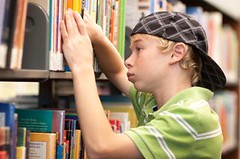
1. Look at the cover – The cover will provide the reader with some idea as to character, setting, and plot. Remember the old adage, however, and don’t judge a book by its cover, alone. Follow the next 5 steps as well to see if this is going to be a book that will interest the reader.
2. Read the title and the author — Read over the title and the author with your child. Maybe this book is by an author that the child has heard or read before and really enjoys. Sometimes children don’t always pick out the author’s name and it is good for an adult to make sure they understand where to locate the author on the cover. This same rule extends to the illustrator as well.
3. Read the blurb in the back – The short synopsis found at the back of most books will give the child an idea of what is going on in the book. It will also provide just enough information to get the reader to read the entire book to find out what else happens in the story.
4. Flip through the book – Look through the book. Notice any illustrations. Take note of the spacing and letter size. These are all good indicators of level of book. The more spacing and bigger letter size is indicative of younger age level. (Unless it is for the visually impaired).
5. Read the first page – Read the first page through with your child to see if the book is one that he/she would still like to choose.
6. Use the 5 Finger Rule – Flip to any page in the book. Have your child read down the page and place a finger on words they do not know.
0-1 fingers – Too Easy
2-3 fingers – Just Right
4-5 fingers – Too Hard
By following the above steps, you should be on your way to finding a book that is not only enjoyable but at the right level for your child. Happy reading!
Alison Murray is a member of the Working Writer’s Club and a Resource teacher with 23 years of experience in the Manitoba education system. Alison has long been interested in writing and has a special interest in researching for non-fiction articles and books. She has completed two courses from the Institute for Children’s Literature.
Article Source: http://EzineArticles.com/?expert=Alison_Murray
by Carol Fraser Boles
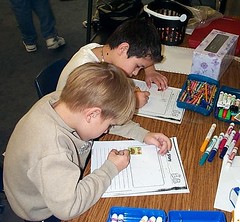
Children make the connection that reading and writing are intertwined at a very young age. Real life examples are in front of them from the day they are born. Their parents are modeling literacy in their daily activities. Children may see their mother reading a recipe to cook a meal, or they watch their father write a check. Children also notice the varieties of written materials their parents receive in the mail – items like newspapers, greeting cards, monthly bills and advertisements – and watch how their parents use them.
As parents you should not only be good models of literacy, you should also send the message that literacy is important. How? By actively supporting your child’s literacy development by reading stories aloud to them, often. Then, talk with them about these stories. Most importantly, have your children write down their thoughts. A journal is a great place for this. Create prompts or questions pertinent to each story you read together. Such as:
Which person in the story did you like best?
What part of the story did you think was funny?
How did this story make you feel?
Did you like the way the story ended? Why?
Can you draw me a picture about this story?
Whether children are pre-school age or are in the early or late elementary grades, parents should participate in their literacy development. There are no wrong answers to questions parents construct. Even the scribbles of a four year old, imbed the reading/writing connection in that child’s mind.
by Carol Boles, Literacy Specialist for the NWFCC
The phrase “literate environment” describes a kind of home and classroom where literacy is promoted and nurtured. Literate environments are where there are displays of literacy in action – competent readers reading. Literate homes and classrooms set aside time for practicing literacy; while also providing a variety of reading choices to encourage and support literacy.

Here are several suggestions for parents and teachers who want to create literate rich environments:
Model- One of the most important things parents and teachers can do is read and show their enjoyment of reading, all the time. When adults display the pleasure reading gives them, children will naturally value and emulate it themselves.
Time - Children must practice reading every day in order to become successful readers. For homes and classrooms to be successful in creating literate rich environments, time needs to be scheduled every day.
Classroom – Teachers need to provide a variety of reading materials to encourage their students to read. Picture books, books on poetry, humorous fiction and non-fiction texts on social studies, science, and even comic books, should be available, for students to explore and read.
Home – Parents need to show an interest in their child’s literacy development. Always look over reading worksheets completed at school and praise your child for their good work. Most importantly, make a point to read aloud to your children.
Books – Parents need to fill their homes with books and other reading materials, as well as take their children to libraries and bookstores. Also, give your children books for gifts, as often as you can.
Reading is a lifelong skill everyone needs. When parents and teachers create literate rich environments, for their children and students, success at reading naturally happens.
Carol Boles is a former public school K-12 Reading Specialist and special education teacher. She has a Master’s degree in Special Reading, is certified in Special Education and has an Educational Specialist degree in Curriculum and Instruction. For more tips to help your children or students become better readers, click here to visit Carol’s blog.
by Suzanne Lieurance
In February, what child doesn’t enjoy receiving and sending colorful Valentine’s Day cards? And whether children make the cards themselves or simply sign their name to a card they buy, the act of sending and receiving Valentine’s Day cards is one that promotes literacy among young children.
Why?
Because it encourages reading, writing, and even talking about the Valentine’s cards with friends and/or family.

Most children love creating a Valentine Mailbox. They can make a mailbox for school and one for home, too. In fact, at home encourage everyone in the family to build a mailbox and exchange Valentines and other cards, notes, and letters all month long. The mail doesn’t need to stop when March rolls around either. Children will be used to the practice of sending and receiving mail by that time and they probably won’t want to give it up. In March, encourage them to create cards and notes for St. Patrick’s Day.
Of course, there are all sorts of reasons to send mail every single day. And by making it fun for kids to send and receive mail, they start to value the written word more and more. And they are doing so in a way that is “authentic” because they really want to be able to read what that card from their father says, or they want to know how to spell a word correctly in a message they are putting in their sister’s mailbox.
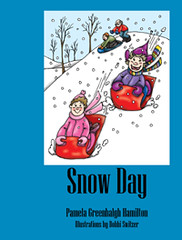
Teachers can also use the mail as a way for children to write about books they read or topics they study in the classroom. Letters or cards can be send from one child to another answering specific questions about a specific book. For example, if kids read Snow Day by Pamela Hamilton (one of the books showcased here this month at the NWFCC), the teacher might ask the class to writer a letter to a friend in class telling who their favorite character was in the book, what they liked best about the book, what they would do differently if they were the writing a book like this, etc. When the children finish writing the letters they can put them in the mailboxes. Later, everyone can read the letters and share them with the class as a class activity.
As a parent or teacher, jot little notes and put them in your children’s or students’ mailboxes throughout the day. If you’re a busy teacher, you don’t have to send a note to every child in your class every day. Just one note a day to one student will do.
It’s also fun if kids can create a mailbox that has a flag that can be raised or lowered when someone puts mail in the box. The raised flag lets the child know “You’ve got mail!”
In the classroom, children can make reading, writing, and distributing the mail a daily practice at a specific time. That way, kids won’t be running around to all the mailboxes at all times of day. They’ll really look forward to the “mail call” part of the day!
by Amy M. O’Quinn

November is the month for turkeys, and Pilgrims and Indians. But it’s also a wonderful time to pull out some books or do unit studies about the pioneers or westward expansion in the United States. Something about sitting around a campfire on a cool evening just makes me think of those brave men, women and children who left kith and kin to set out on a cross-country journey to find a better life or adventure thousands of miles away. The hardships were many, and danger was a daily companion, but the joy, excitement, and expectation of something better pushed them forward.
Children love to study this period of history, and the ideas for activities are countless. A great resource to use is Pat McCarthy’s book, Heading West: Life With the Pioneers, 21 Activitie. Not only does it cover the life and daily activities of the pioneers; information about our country’s prominent leaders at the time, events that were happening in the nation, conflicts with Native Americans, etc. is also included.
Here is a synopsis from the publisher:
“Tracing the vivid saga of Native American and pioneer men, women, and children, this guide covers the colonial beginnings of the westward expansion to the last of the homesteaders in the late 20th century. Dozens of firsthand accounts from journals and autobiographies of the era form a rich and detailed story that shows how life in the backwoods and on the prairie mirrors modern life in many ways–children attended school and had daily chores, parents worked hard to provide for their families, and communities gathered for church and social events. More than 20 activities are included in this engaging guide to life in the west, including learning to churn butter, making dip candles, tracking animals, playing Blind Man’s Bluff, and creating a homestead diorama.”
McCarthy has done the research and legwork to provide educators and homeschooling families with a resource that is interesting and practical. The activities are fun and do-able, and they don’t require materials that are hard to find. Students will enjoy the experience of doing ‘pioneer’ chores and learning what life was like for children on the trail and out West. They will find out that everyone had to pull together to survive, yet they still found time to have fun and fellowship.
This month, consider a study about pioneers and the westward movement—and use Pat McCarthy’s book, Heading West: Life With the Pioneers, 21 Activities to help you ‘hit the trail’.
*******************************
Visit Amy O’Quinn at amyoquinn.com.
by Amy M. O’Quinn

As parents and educators, we are always looking for ways to inspire our children and foster a love of learning within them. We know that reading aloud to them, investing time doing projects with them, and seeking out great learning resources for them are all beneficial. But sometimes letting our children participate in activities with other kids who have similar interests is also a good thing. Students discover and learn new things together, which in turn develops camaraderie and friendship.
Why Are Book Clubs Appealing?
Book clubs are becoming more and more popular as such an activity. In fact, according to Jennifer Thompson, a reading specialist for the Manassas City Public Schools in Virginia and a contributor to the GreatSchools Book Nook, adds, “Book clubs are so appealing because children can truly get lost in a book without standardized tests looming, no comprehension questions to answer, just the pure satisfaction, of reading for enjoyment. Book groups offer a venue to bring the lone act of reading, into a social circle.”
However, more research from the Center for Summer Learning at Johns Hopkins University shows that participation in extracurricular or even summer reading programs (done just for enjoyment) does indeed raise reading test scores and improve academic skills overall. Elementary children who take part in book clubs are less likely to be held back in future years, and believe it or not, reinforcing reading skills over the summer actually prevents hearing loss!
Types of Book Clubs
There are several types of book clubs, so do some research to find what works best for your child. Of course, almost everyone is aware that most local libraries sponsor a summer reading programs for children in the community. This usually involves reading a certain number of books to earn rewards. But sometimes librarians will also host an actual ‘read and discuss’ type book clubs for children, teenagers, or adults. Inquire at your local library to see if this is an option for your child.
There are also school sponsored book clubs in many areas, and they usually are held in the afternoon after classes are finished for the day. However, this type of club works best for older students, as younger children are dependent on carpools or bus rides to get home. However, some classroom teachers are making an effort to set aside some time during the day for students to read and discuss literature together—just for enjoyment!
Probably the fastest type growing book clubs are those that are organized independently by parents or students themselves. The focus of these clubs varies widely—boys’ reading clubs, girls’ reading clubs, classic literature, Newberry titles, history, Christian literature, science, etc. Some clubs are eclectic and encompass many different types of genres.
Another popular one is a Children’s Book Club Tea Party. Nevertheless, regardless of the focus, the idea is to get children reading and discussing. Tossing around ideas about themes or characters teaches students to comprehend, think, and even be ready to defend or rethink their own opinions. This expands the mind!
Links and Resources:
For more information about children’s book clubs or how to form one, check out these sites:
http://www.kidsreads.com/clubs
http://www.litlovers.com/kids_club3.htm
0 Comments on Book Club Benefits as of 1/1/1900
by Jeff M. Roth
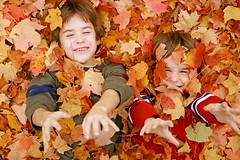
Parents understand that as the Fall season approaches and the weather begins turning frigid, in many regions of the U.S. its time to come up with alternative activities for kids aside from the standard outdoor selections. While some Fall toddler and preschooler activities can be weather permitting, our suggestions below are all indoor and offer moms a chance to have a fun afternoon with their kids while not breaking the bank in the process.
1) Duckpin Bowling or Bumper Bowling – Check with your local bowling alley and most will inform you of a 1/2 off day or $1/game special, usually midweek during the afternoon hours. Most bowling alleys are slow during the day and need customers thus offering deep discounts to take advantage of. Try to get them to include free shoe rental as part of the deal as most will do so. Even toddlers and preschoolers can participate in Duckpin or Bumper Bowling and have a blast.
2) Day at the Library – How quickly moms forget how much fun kids have at the library. Most public libraries have library storytimes and toddler activitieson a weekly basis in the Fall. Even if there’s not a storytime or event going on, kids love libraries. Usually loaded with comfy beanbag chairs and puzzles for the youngsters, these types of preschoolers activities usually are a winner and best of all free.
3) Kids Movie Days – Unbeknownst to many moms, some local movie theaters have a day of the week where they offer cheap movies for moms with toddlers and young children only. Usually on a Tuesday or Wednesday during off peak hours, theaters offer kid themed movie offerings that allow kids to be kids. No worries about being too loud or sitting still. If your child truly wants to watch the movie, this might not be the choice for you! Usually a nice reprieve for moms but bring your own food as they’ll get you on the full priced popcorn and drinks.
4) Attend a Local Hockey Game – If there’s a local hockey rink in your area, guaranteed there are many hockey games going on throughout the day and night. If your child enjoys sports or just watching other little ones, they’ll love watching other kids playing hockey. Whether its a high school match or just a scrimmage or tot league, its usually free or minimal in cost. These rinks tend to be very loud and echo filled so kids noise is easily drowned out. Don’t worry about paying $7 for a drink or $10 for nachos in these establishments either.
5) Arts and Crafts – Call up a local arts and crafts store and ask if they have any upcoming demonstrations or ‘how to’ classes directed towards kids. Usually these sessions are meant to drum up future business and draw in moms to purchase supplies and thus are free or minimal cost. Sometimes you’ll have to pay for the supplies used during the class so make sure to choose wisely but it usually ends up in an enjoyable crafts for kids adventure.
Have a wonderful Fall 2010!
Jeff Roth is CEO of TotActivities.com, launched in 2010 to help moms with young children find upcoming local toddler activities and activities for kids.
Article Source: http://EzineArticles.com/?expert=Jeff_M_Roth
by Amy M. O’Quinn
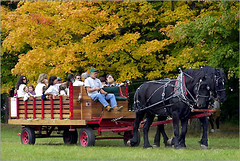
Leaves are changing colors and falling gracefully to the ground. There is a definite nip in the air, and pumpkins are finding their way onto doorsteps and porches for decoration and yes—into ovens as pies and muffins! Hearty soups warm up tummies, while flickering flames in fireplaces cozy up homes and warm hearts. Families everywhere are celebrating the harvest season with fun outings and activities for everyone!
Need some ideas for harvest time fun? Here are a few suggestions!
Visit a pumpkin patch. Many pumpkin patches offer lots more than just pumpkins! Often you will find these seasonal businesses have all kinds of fun activities for the whole family. For example, they might also just have. . .
Travel a Corn Maze. Many owners utilize a tractor equipped with a GPS to create a pattern and paths in a field. Visitors therefore must navigate through the maze to find their way along paths in a field of cornstalks that can be eight to nine feet high and finally make their way out the other side. Many patches offer nighttime mazes as well. Fun! You might also discover these businesses offer. . .
Try a Hay Ride. Who doesn’t enjoy a hay ride on a brisk autumn day? Whether it’s a wagon pulled by a tractor or horses, a hay ride is the stuff memories are made of.
To find pumpkin patches or corn mazes in your area, check out www.pumpkinpatchesandmore.org for suggestions and other fun stuff. The listings are by state, then they are broken down further by region and/or county.
Once you’ve picked a pumpkin, the next idea is to. . .
Create a carved or painted pumpkin. Although many children do want to make traditional jack o’ lanterns, there are many other ideas as well. For example, some people like to use designs such as maple leaves, monograms, words, cornucopias, silly faces, etc.
Roast pumpkin seeds. Recipes abound on the internet, so just do a search.
Some Additional Ideas:
Go apple picking. Then use the produce to make homemade applesauce or apple pie. Don’t forget caramel apples! Children will also enjoy the art of apple stamping. Simply cut an apple in half; gently dab the cut apple on some paint, and stamp away on paper or fabric to create fall masterpieces. Easy!
Take a drive to admire the beautiful autumn foliage. Take lots of photos and collect some leaves
to. . .
Make leaf rubbings or preserve the colorful foliage with glycerin or between sheets of wax paper to enjoy for several weeks.
Drink hot cocoa and roast marshmallows around a bonfire. Tell stories and sing songs.
For something a little bit different. . .
Make Sweet Potato People Creations. Yes, the pumpkin is usually the star of the show in autumn, but sweet potatoes are a nice alternative. In our community, the sweet potato is celebrated with a parade, an arts and crafts exhibit, games, activities and contests. My children participate in the 4H Sweet Potato Decorating Contest each year, and they have come up with amazing ideas such as a ‘Guard at Yammingham Palace’ complete with red uniform and black furry hat. I have seen sweet potato mice, sweet potato dogs, and sweet potato princesses. What creations can your children come up with?
Read autumn themed books together. One such great book, The Gigantic Sweet Potato by Dianne de Las Casas, follows along nicely with the idea above, and would make a super read-aloud
by Sharon Blumberg
Spooky Story Starters can foster creative writing by children and young adults. Children can also draw illustrations to accompany their stories. Most children grow up with many unforgettable spooky Halloween experiences. Help your child, or your students if you’re a classroom teacher, create some fun spooky stories for Halloween.
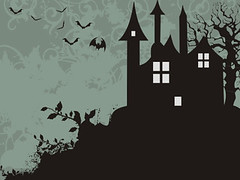
Before you have your children start writing, remind them that effective stories for children need to contain essential elements. Aside from a beginning, middle, and end, those elements are as follows:
1. A point of view character. Write the story from the point of view of the main character.
2. A problem or conflict for the main character. The story must have a problem that needs to be solved. Try to present this as early in the story as possible in your story, or your reader will move on to something more enticing.
3. Rising action. Once your problem is established, create some rising action, where the conflict begins to build in intensity.
It is acceptable to have parents involved in the story, but the main character should try and solve the problem himself/herself.
4. Dialogue and Action. Try to tell much of the story through dialogue. In other words, “show,” don’t just “tell.” Be sure you have plenty of action, though. You story needs to be MORE than just people talking.
5. A Twist. Have your story end with an unexpected “twist.” This could be something the reader never saw coming, but would wonder why he didn’t.
Now for some Spooky Story Starters to help your children start writing:
1. You just moved into an old, large home with your family, in a new town. Everyone at school tells you the house is haunted. You are alone on Halloween evening, giving out candy, when you hear footsteps coming from the stairway.
2. Nobody ever Trick or Treats at the dark house on the corner of your block. Children have seen a shadowy silhouette of a women peering out of a second story window, and viscious dog-barking rattles the front windows. Your companions have dared you to ring the bell for Trick or Treat.
3. Every Halloween night, your neighbor down the street tries to scare children by growling, and jumping out of his door while wearing a costume. In addition, creepy-sounding Halloween songs blast from a boom box on his lawn. However, this year you notice something a little different. You don’t see your neighbor jumping out with a costume, nor do you hear the scary Halloween music. What you do see is a tall, dark hooded figure standing behind a clump of tall, evergreen trees near your neighbor’s house. Your friends still want to go Trick or Treating at this house. You don’t want to go, but you don’t want to seem like a wimpy baby by backing out.
4. You are interviewing a well-known vampire about his best Halloween memory. He is known for terrorizing bullies in the neighborhood on Halloween night. He tells you one time he…..
5. You have gone Trick or Treating ever since you were a young child because this particular house gives out the best treats. You are now 12 years old, but you are not quite ready to give up Trick or Treating while you still have younger friends. The lady at the door insults you by saying you are much too old to still be Trick or Treating. In fact, she says you should be ashamed of yourself. But she eventually gives you a big candy bar anyway.
by Suzanne Lieurance
If you’re the parent of young children or a preschool teacher, here’s a fun activity to try with your kids that will help them become better readers.
First, choose a picture book your children love. Make a point to read this book to your children, or to your class, every day for several days. As you read, read slowly, allowing the children to figure out where you pause and turn the page while you’re reading. Point out the pictures on each page. You might even want to follow the words on each page with your finger as you’re reading.
After a few days, notice that your children, or your class, seem to be able to read the pages right along with you. In fact, ask them to do this as a class. They won’t be able to “read” the words, of course. But they will be able to pick up on what words “should” be on each page. They’ll memorize the text this way if you choose a very simple book with few words and pictures that illustrate the words on each page.
Here are some great books to use for this activity:

Raindrops A Shower of Colors by Chieu Urban
This book has big, bold illustrations and few words on each page with repetitive use of the words Go! Go! Go! that make it easy for children to memorize the words and fun for them to say them out loud. The words on each page have many cues and clues to help the child remember them. For example, The first two pages of the book are:
Page 1:
The text is very short and simple: Purple parrot
The Illustration is a big clue and cue to the reader: A big purple parrot holding an umbrella
Page 2:
The text is short and simple: Pink pig
The illustration is a big clue and cue to the reader: A big pink pig holding a daisy
With the exception of pages that say Go! Go! Go! – each page is alliterative text, where the words, colors, and illustrations all fit together to give the child clues and cues as to the words on that page.
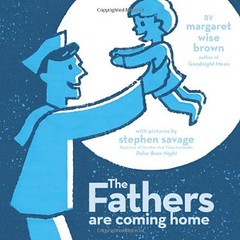
The Fathers are Coming Home, By Margaret Wise Brown, illustrated by Stephen Savage
The text in this picture book is a bit more extensive than the text in Raindrops. Yet, again the illustrations provide clues and cues for the reader. And, you’ll probably be surprised at how well the children remember most, if not all, of the words on each page once you’ve read this book to them many times. As you’re reading this story out loud, read slowly and say the words clearly, giving each word the importance it deserves.
Both of these books have minimal text, which is what you want for this activity because, basically, the children will be memorizing the text as you read it over and over to them. Then, once you ask them to “read” the text themselves, they will be reciting it to you from memory as you turn the pages. They will “feel” as if they’re reading, though, and they will be learning many things they need to kno
by Amy M. O’Quinn
I have mentioned before how much we value literature in our home—for instruction as well as enjoyment. I try to find ‘living’ books as much as possible to share with my children when they are learning about new things. I believe they benefit from reading whole books written by authors who are truly passionate about their subject matter, as opposed to dry tidbits scattered here and there throughout textbooks.
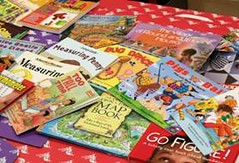
Although it is obviously easier to locate ‘real’ books pertaining to history or science, I have also discovered an ever-growing collection of literature that introduces or reinforces mathematical concepts as well. Not only are basic skills covered; an interesting story line draws the children into the book and holds the attention of even the most reluctant math students. They are often unaware they are learning important concepts as they follow the story. As most of my children are not particularly math-minded, this is a good thing!

For example, the six book Sir Cumference series by Cindy Neuschwander is perfect for introducing all kinds of geometry concepts to younger students, and my children loved them. The author skillfully plays on math terms to create the names of the characters—Sir Cumference, a knight in the kingdom of Camelot, his wife, Lady Di of Ameter, and their son Radius. Even the whimsical titles are brilliant and give an indication of the skills covered in each book:
Sir Cumference and the First Round Table
Sir Cumference and the Dragon of Pi
Sir Cumference and the Great Knight of Angleland
Sir Cumference and the Sword in the Cone
Sir Cumference and the Isle of Immeter
Sir Cumference and All the King’s Tens
To find out more about using literature to teach math, check out http://www.mathcats.com/grownupcats/ideabankmathandliterature.html. Moreover, if you are specifically interested in finding a list of ‘mathematical’ books that are organized by category and age level, follow the link on that page to http://sci.tamucc.edu/~eyoung/literature.html.
Using picture books and great literature to teach mathematical concepts is a win-win situation!
 Amy M. O’Quinn is a pastor’s wife and former schoolteacher-turned-homeschool mom of six. She is also a freelance writer who enjoys jotting down ideas around the fringes of family life. She specializes in non-fiction, and her work has been published or acquired by various magazines including Jack and Jill, US Kids, Guideposts for Kids, Learning Through History Magazine, Highlights, GEORGIA Magazine, Homeschooling Today, International Gymnast, etc. She is also a product/curriculum/book reviewer for The Old Schoolhouse Magazine and a regular columnist for TEACH Magazine. The O’Quinns live on the family farm in rural south Georgia. You can visit Amy at amyoquinn.com.
Amy M. O’Quinn is a pastor’s wife and former schoolteacher-turned-homeschool mom of six. She is also a freelance writer who enjoys jotting down ideas around the fringes of family life. She specializes in non-fiction, and her work has been published or acquired by various magazines including Jack and Jill, US Kids, Guideposts for Kids, Learning Through History Magazine, Highlights, GEORGIA Magazine, Homeschooling Today, International Gymnast, etc. She is also a product/curriculum/book reviewer for The Old Schoolhouse Magazine and a regular columnist for TEACH Magazine. The O’Quinns live on the family farm in rural south Georgia. You can visit Amy at amyoquinn.com.
by Amy M. O’Quinn
I’ve often said that children are fascinated by topics that have a high gross factor. And what is more gross than exhuming skeletons that have been buried for over four hundred years so that forensic scientists can learn more about life (and death) in the 1600s and 1700s?
Forensic Anthropology
This branch of science is called forensic anthropology and involves special archeological techniques that keep the digging from ruining the skeletons and preserve the site as much as possible to keep everything intact.
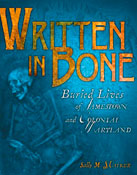
Interestingly, Dr. Douglas Owsley, a scientist with the Smithsonian Institute, teamed up with award-winning children’s writer, Sally M. Walker, so she could create a book called Written In Bone: Buried Lives of Jamestown and Colonial Maryland to chronicle just such an archeological/forensic adventure!
Dr. Owsley and his team of scientists excavated several graves at the site of the old James Fort in Jamestown, Virginia in 2005, with the “goal of better understanding the Europeans and Africans who lived in Jamestown and the Chesapeake Bay area during the 1600s and 1700s.” (From front flap of Written in Bone)
“Just as forensic scientists use their knowledge of human remains to help solve crimes, they use similar skills to solve the mysteries of the long ago past. From the skeletons, the burial practices, and remnants of objects found nearby, scientists can determine gender and ancestry, along with probable age, what the person ate, what lifestyle he or she lived, and the cause of death. In some cases, further research helps scientists speculate on who the dead were.” (From front flap of Written in Bone)
Colonial Lives and Deaths
The author, Sally Walker, was able to experience firsthand another dig in Talbot County, Maryland when Dr. Owsley and his crew excavated the unmarked graves of twelve colonial settlers. Therefore her book gives an absolutely fascinating peek at what this type of archeological project involves. Within the pages of Written in Bone, we learn about a teenage boy who probably lived a harsh life and died with an Indian arrow embedded in his thigh. We find about the ceremonial burial of a high ranking ship’s captain who was laid to rest with his leading staff by his side. We also learn about a family buried in lead coffins, another young boy who obviously died a violent death and was buried in a trash pit underneath a house, and an African slave girl.
Books/Resources
Forensic anthropology, and even forensics in general, is a very interesting subject to investigate further. Here are a few more suggestions:
The Bone Detectives: How Forensic Anthropologists Solve Crimes and Uncover Mysteries of the Dead by Donna M. Jackson and Charlie Fellenbaum
The Forensic Anthropologist (Crime Scene Investigations by Diane Yancey
Forensic Science (DK Eyewitness Books) by Christopher Cooper
You can also learn more about Written in Bone at
0 Comments on Forensic Antropology and Written in Bone as of 1/1/1900

























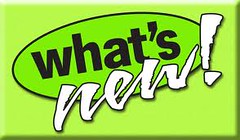
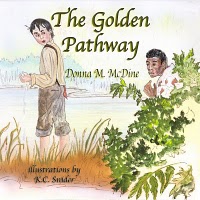
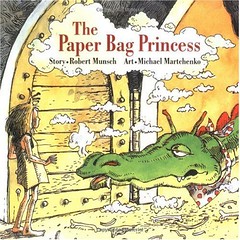
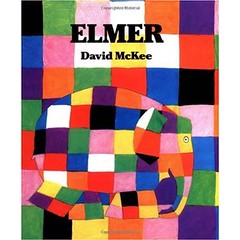

I totally agree with what you wrote, but there is an additional component that is essential to help children learn to read. Everyone has their own learning style. I found when I was teaching, that if I was able to identify what learning style each child had, especially the ones that were having problems, I could facilitate their reading abilities. The basics, of course are auditory, visual and kinesthetic and there are hundreds of tests to ID learning styles. However I used observation and some basic activities which resulted in children who really enjoyed reading. I think identifying learning styles is a very important factor.